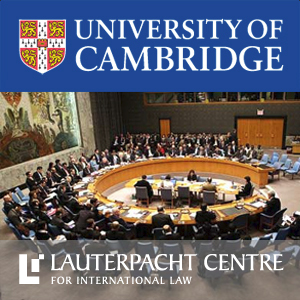Hersch Lauterpacht Memorial Lecture 2010-11, Part 2: 'The United Nations of the Future.The Role of International Law in UN Reform'' by Dr Nico Schrijver
Duration: 1 hour 5 mins
Share this media item:
Embed this media item:
Embed this media item:
About this item

| Description: |
The Hersch Lauterpacht Memorial Lecture is an annual lecture series given in Cambridge to commemorate the unique contribution to the development of international law of Sir Hersch Lauterpacht. These lectures are given annually by a person of eminence in the field of international law and a revised and expanded version of the lectures is usually published in the Hersch Lauterpacht Lecture Series by Cambridge University Press. The lecture comprises three parts, delivered on consecutive evenings, followed by a Q&A session on the fourth day.
The 2010-11 Hersch Lauterpacht Memorial Lecture series, entitled 'The United Nations of the Future. The Role of International Law' was delivered at the Lauterpacht Centre for International Law, University of Cambridge, by Dr Nico Schrijver, Chair of Public International Law, Leiden University and President of the International Law Association, from Tuesday 22nd to Friday 24th February 2011. This part, entitled 'The Role of International Law in UN Reform' was the second of the three lectures given. Unfortunately, the third lecture in the series was not recorded. |
|---|
| Created: | 2013-04-11 14:13 |
|---|---|
| Collection: | LCIL International Law Seminar Series MOVED |
| Publisher: | University of Cambridge |
| Copyright: | University of Cambridge |
| Language: | eng (English) |
| Keywords: | United Nations; International law; international organizations; Reform; |
| Abstract: | Second Lecture : The role of international law in UN reform
International law can be viewed as both an impediment to and a stimulus for UN reform. Obviously, the formal amendment procedures of the UN Charter and other statutes restrain reform to a considerable extent. But international law has also proved to be flexible and pragmatic in fostering or at least accommodating the need for reform. This lecture seeks to identify various legal techniques employed towards this end. These include evolutionary and creative treaty interpretation, the emergence of new rules of customary international law, ‘permissive’ and ‘programmatory’ resolutions of the UN General Assembly, the advisory jurisdiction of the International Court of Justice, the establishment of new organs (such as UNCTAD and UNEP) and the creation of new compliance mechanisms (e.g., peace-keeping operations and special human rights procedures). 2010-11 Lectures: Overview Reform of the United Nations is as old as the world organization itself. Throughout its existence numerous reform proposals have been put forward. However, ‘big bang’ reform has not proved feasible. Instead, gradual reform has been achieved by a series of incremental measures in the absence of agreement among the great powers on fundamental reform. Perhaps the most significant reform has occurred as a result of the evolution of the UN’s goals and objectives. It has evolved from a primarily peace and security organization into a general global justice organization that pursues various new objectives many of which were not foreseen in 1945 such as decolonisation, sustainable development and post-conflict peace-building. This development has also led to evolutionary and creative interpretations of the mandates of the principal political organs of the United Nations, most notably those of the General Assembly and the Security Council. Throughout the existence of the United Nations, the meaning of the key concepts of peace and security, human rights, self-determination and development have changed considerably: from ‘negative’ towards ‘positive’ peace and from military towards comprehensive security; from Cold War human rights rhetoric towards universality and indivisibility; from external towards internal self-determination and ‘good governance’; from economic development towards sustainable development. There has been a proliferation of UN organs, funds, programmes, commissions and committees at the institutional level although the basic structure of the United Nations as an organization of member States with six principal organs and associated specialized agencies (Bretton Woods institutions, FAO, UNESCO, etc.) has remained intact. Nevertheless, it has become patently evident that bold reform of the UN at the beginning of the 21st century is essential if the organization is not to risk losing its representativeness, legitimacy and credibility as well as effectiveness. This lecture series looks into the options for bold reform and examines what the role of international law in this could and should be. Consequently, the focus of the lecture series is on the United Nations of the Future rather than on the future of the United Nations. |
|---|---|

